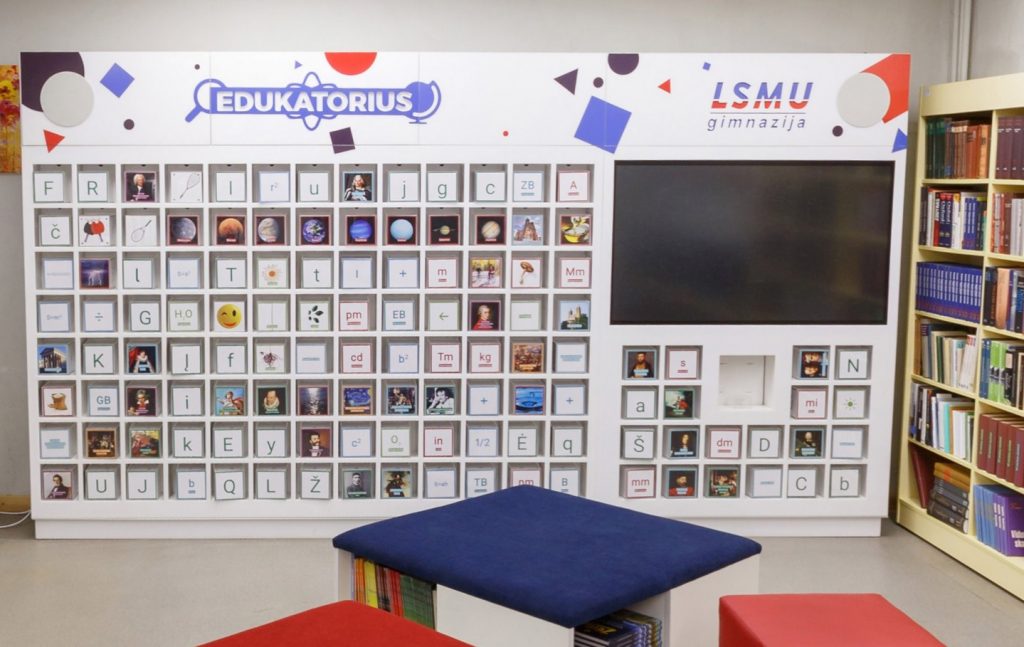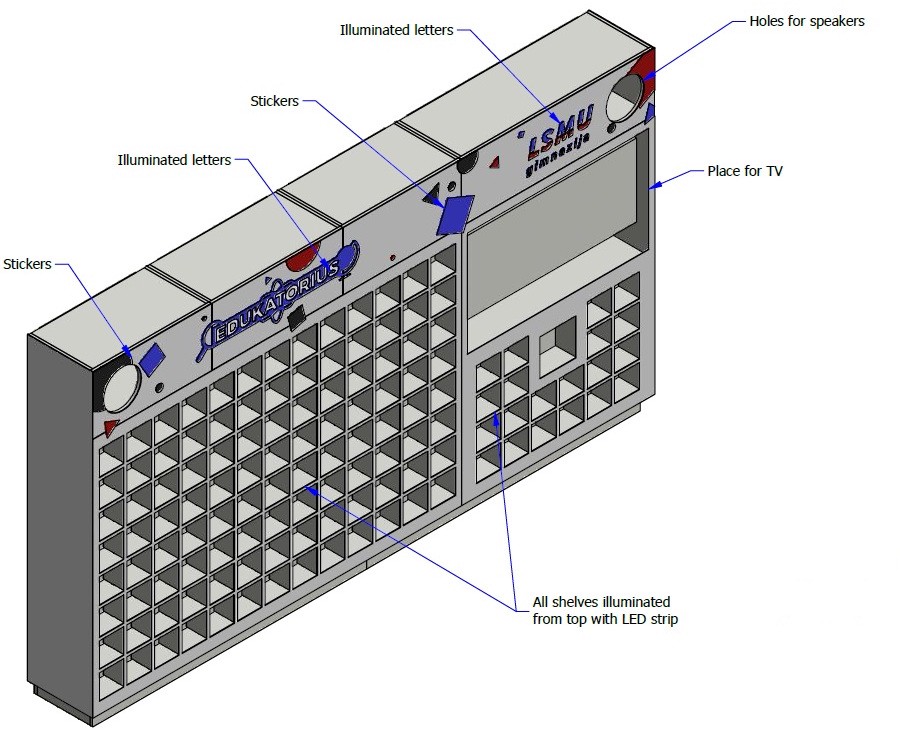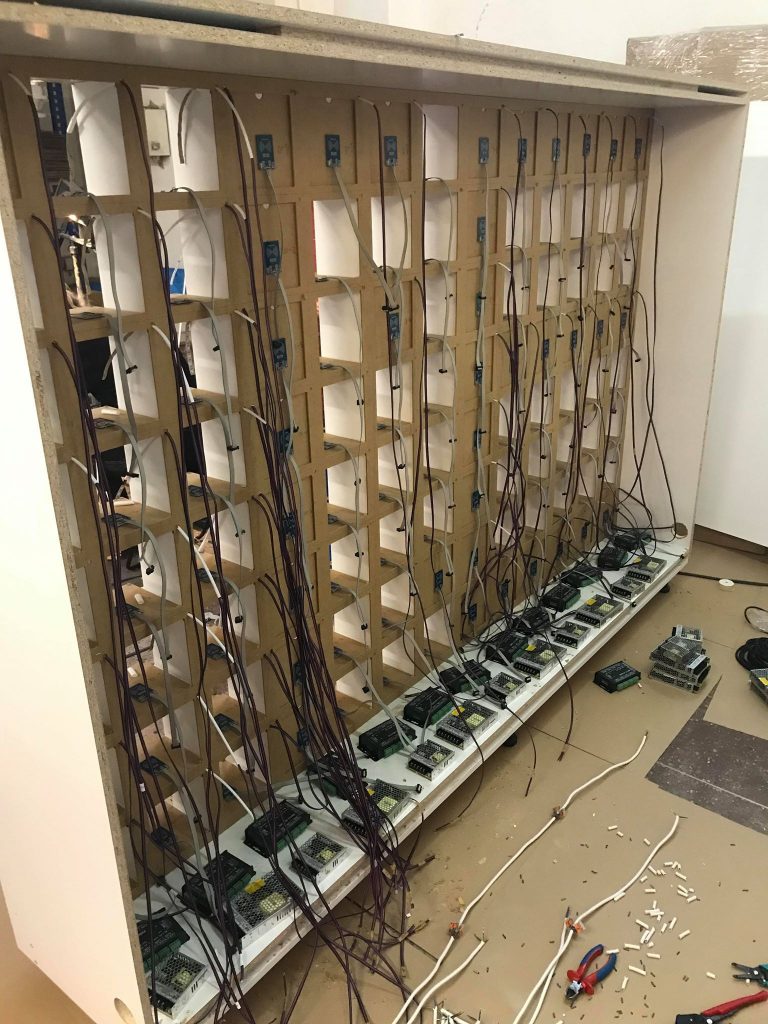
Combining Hardware, Software and Content Solutions for a Room-Sized Educational System
What happens when a digital creative studio such as SneakyBox, focusing on games, custom software and immersive solution development, decides to take action in a field of education? They introduce a unique trailblazing blend of hardware, software and educational content. It has 125 input cubes, spans almost four meters to the sides and has been named “The Educator” (“Edukatorius”).

Perpetual education
The Educator itself was developed for more than four months with the cooperation of the local Lithuanian University of Health Sciences gymnasium (LSMU gymnasium) and over a couple of blog posts, we will expand on the specifications and creative challenges of the project.
The initial idea to build something of sorts came into our minds after meeting the director of the gymnasium Arunas Bucnys. As it probably is in many countries, in Lithuania, there are several funding programs focused on technical upgrades for the educational institutions. Typically schools just spend those grants acquiring tablets, computers, sometimes smartboards, but very frequently that’s where it all ends. Content creation and usability of these technologies are left for the teachers or kids alone to figure out. In this case, LSMU wanted something unusual, not just a technical tool but a system which would allow to create new content and be easy enough to use both for educators and students alike. After researching numerous different solutions, ways to present content and create engaging tasks, together we decided to mix several ideas and build a system that combined hardware, software and content creation solutions.

As our previous experiences with educational content have shown, gamification could be on the cutting edge of innovation in current education systems. The World Government Summit report on Gamification and Future of Education states that since information could be distributed far more cheaply on digital screens than in books and it can offer instant feedback, educational systems depend much less on the number, cost, and time availability of teachers. Additionally, with game-based motivations, students have less need for teachers’ constant discipline and supervision to conduct their work. With that in mind, we started to distinguish our core principles of The Educator:
Interactive
The first major feature we had aimed while developing the system was instant feedback while providing inputs. The finished project examines input cubes in real-time and provides information about the task on the screen without any delay.
Gamified
Gamification is not a new term in education. As it increases students’ focus and engagement, it could be a powerful tool for teachers that are ready to dabble in it. The Educator in itself provides the functionality needed to gamify the learning process, whether it is just looking for information or various task solving.
Empowering teachers
We envisioned the project as a living ever-changing tool for teachers, so another crucial principle in development was to find a way to empower them to use the system in everyday tasks as much as possible. We implemented it by installing the ability for teachers to create, edit or customize various tasks themselves.
COVID timing
As with everything that happened since the beginning of spring, delivery of our system coincided with the start of the pandemic. We were lucky enough to have The Educator ready just before the school closure, so students and especially teachers had a chance to give it a go understanding how everything works and taking tome time to solve the tasks themselves.
We received immediately positive reaction from the kids. The system was built in the gymnasium’s library, where students spend much of their time both during and after lessons. As the LSMU director has told, The Educator was constantly running until the late hours, used by students staying in school to do homework or other extra-curriculum activities. The system notably fascinated younger kids, as the gymnasium starts from 5th grade. A. Bucnys noted, that such tools would be especially beneficial and effective even for primary schools, as the current generation of children already grew up with various devices and interactive content all around them.

For the teachers, the story is a bit different and the whole digitalisation movement is just starting. The lockdown of schools, of course, was unfortunate for many reasons and in this case, teachers did not have enough time to learn everything about the possibilities of The Educator and methods to create new content. As the system requires physical presence, it can’t be used for online learning. On the other hand, remote classes nudged people in the educational community towards becoming much more tech-savvy and incentivised them to adopt new interactive ways to present content and provide tasks for kids. For the upcoming academic year, everything should move much faster and smoother with additional content and engaging tasks for The Educator.
Assembly required
It is worth mentioning that the project of such complexity also presents a fair share of challenges and hurdles one must pass to finalize it. We already had quite versatile experience developing interactive solutions for museums or expo shows, but this project contained a different level of complexity. The size of the system’s frame of almost eight square meters required a novel approach to hardware solutions. It was made and assembled by our great technical partners Lazertechas and together we had to build and deconstruct it several times before putting all the pieces together and assembling for the final time in the gymnasium library.

At the end of the day, projects such as The Educator are only as good as the people using it, so naturally, another challenge arose to instruct the teachers on how to use this unusual tool. To tackle this hurdle we prepared the administrator’s manual and organized internal courses for small teachers’ groups on how to use The Educator, create additional exercises and add supplementary information.
And now let’s dive deeper into how everything was created and put together.
First off — the frame
Even though we are not amateurs when it comes to developing interactive solutions for museums or expo shows, The Educator is a little more complex than we are used to. Speaking just in physical parameters, it takes up almost 8 square meters, has 125 docks for input cubes, a dedicated speaker and TV screen sections. All of this was accomplished by our great technical partners Lazertechas. When describing the frame structure, it is worth noting that the back wall is fixed with magnets to provide easier maintenance when needed.
Another important thing we had to keep in mind while assembling The Educator was the fact that it might be challenging to keep a working computer cool inside the frame itself. To prevent overheating, additional cooling systems were set in place.

The magic behind input boxes
There are 125 input boxes and the device registers inputs in all of them while it is operating. This is achieved by installing special RFID (radio frequency identification) readers at the back of each input box. This way, every time a new block with RFID tag is placed in the box, the reader records it as an input. This also lets the system register the precise side of the box that was inserted into it.
For users to recognise which input boxes to use, each input box had to be equipped with a distinctive LED lighting that could turn on upon command. So LED lights that were installed during the initial assembly of the frame had to be supplemented by 13 additional LED controllers that were connected to control illumination of the input boxes.

Switches and engines that make it work
Now — the interesting stuff begins. Inputs from RFID readers have to be processed and registered accordingly in the main computer. To correctly transfer the inputs, we have used 18 Arduino controllers. Each of the RFID readers was attached to the Arduino and they were connected to the network via LAN. The controllers would constantly monitor RFID information and relay exact input IDs or the fact that the box is currently empty. All of this data is processed via custom made software which runs on the main computer. The main computer is connected to the remote content management system. The content management system was developed using Laravel PHP framework and allows the teachers to create new exercises or update the relevant information accordingly.

Of course, The Educator assembly was not without its challenges — at the initial assembly, we could only install LED lighting, while everything else had to be connected at the spot. This included RFID readers, LED controllers and Arduino controllers, not to mention all the wiring. During this process a problem occurred, where some of the Arduino network shields were faulty, so our partners at Surikatos.lt had to fix them manually. We would like to thank them as their expertise in this field has helped us a lot throughout this project.

As the schools are again opening their doors to their pupils, we can proudly assess the accomplishments we have achieved working on this project. Not only this was a new experience for us conceptually, but it also required a great deal of in-depth expertise in the hardware field. Now, with The Educator behind, it’s time to embrace the upcoming challenges and experiences. More on that in our upcoming blog posts!
